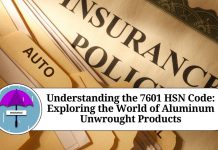When it comes to the manufacturing and trading of goods, it’s important to know the Harmonized System of Nomenclature (HSN) codes. These codes are used to classify products and help ensure consistency in international trade. In this blog post, we’ll specifically focus on ink HSN codes and explain what they are and why they matter.
What is an HSN Code for Ink?
An HSN code for ink is a six-digit code that is used to classify different types of ink products. This code is part of a larger coding system that is used to categorize all goods in international trade. The HSN system was developed by the World Customs Organization (WCO) and is used by over 200 countries worldwide.
The HSN code for ink typically falls under the broader category of “printing ink, writing or drawing ink, and other inks.” Within this category, there are several subcategories that are used to further classify different types of ink products based on factors such as their composition and intended use.
Why Do Ink HSN Codes Matter?
Ink HSN codes are important for a number of reasons. Here are a few key ones:
- Facilitating International Trade
HSN codes are used to facilitate international trade by providing a standardized system for classifying goods. This makes it easier for customs officials to identify and process shipments, and it helps ensure that products are subject to the correct tariffs and other trade regulations.
- Ensuring Product Quality and Safety
In some cases, ink products may be subject to safety and quality regulations. By using an HSN code, regulators can more easily identify which products are subject to these regulations and ensure that they are being produced and traded in compliance with relevant standards.
- Simplifying Business Operations
By using HSN codes for ink products, businesses can more easily manage their inventories and sales records. This can help streamline operations and reduce the risk of errors or misclassifications.
Ink HSN codes may seem like a small detail, but they play an important role in international trade and commerce. By understanding these codes and ensuring that products are correctly classified, businesses can avoid unnecessary delays, penalties, and other complications that can arise from noncompliance with trade regulations.
Read more useful content:
Frequently Asked Questions (FAQs)
Q. What is an HSN code for ink?
An HSN code for ink is a six-digit code used to classify different types of ink products. This code is part of a larger coding system used to categorize all goods in international trade.
Q. Who assigns HSN codes for ink?
HSN codes for ink are assigned by the World Customs Organization (WCO), which is responsible for maintaining the HSN system.
Q. How do I find the HSN code for a specific type of ink?
You can find the HSN code for a specific type of ink by consulting the WCO’s Harmonized Commodity Description and Coding System, which provides a comprehensive list of HSN codes for all types of goods.
Q. Why is it important to use the correct HSN code for ink products?
Using the correct HSN code for ink products is important for several reasons. It helps ensure that products are subject to the correct tariffs and trade regulations, and it can help facilitate international trade by providing a standardized system for classifying goods.
Q. What are some common subcategories of ink products under the broader category of “printing ink, writing or drawing ink, and other inks”?
Some common subcategories of ink products under this broader category include printing ink, stamping ink, fountain pen ink, ballpoint pen ink, and ink for inkjet printers.
Q. Are there any safety or quality regulations that apply specifically to ink products?
In some cases, ink products may be subject to safety and quality regulations, particularly if they are intended for use in food packaging, medical applications, or other sensitive contexts. By using an HSN code, regulators can more easily identify which products are subject to these regulations and ensure that they are being produced and traded in compliance with relevant standards.




















